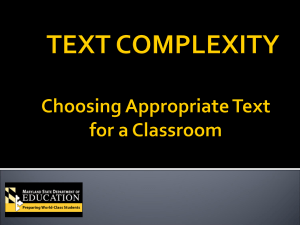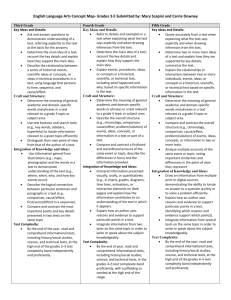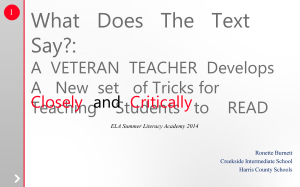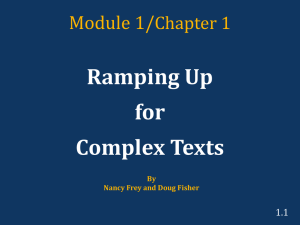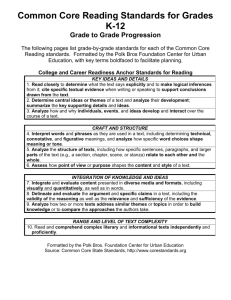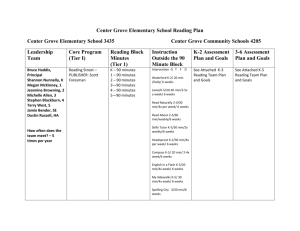Warm Winter Standards
advertisement
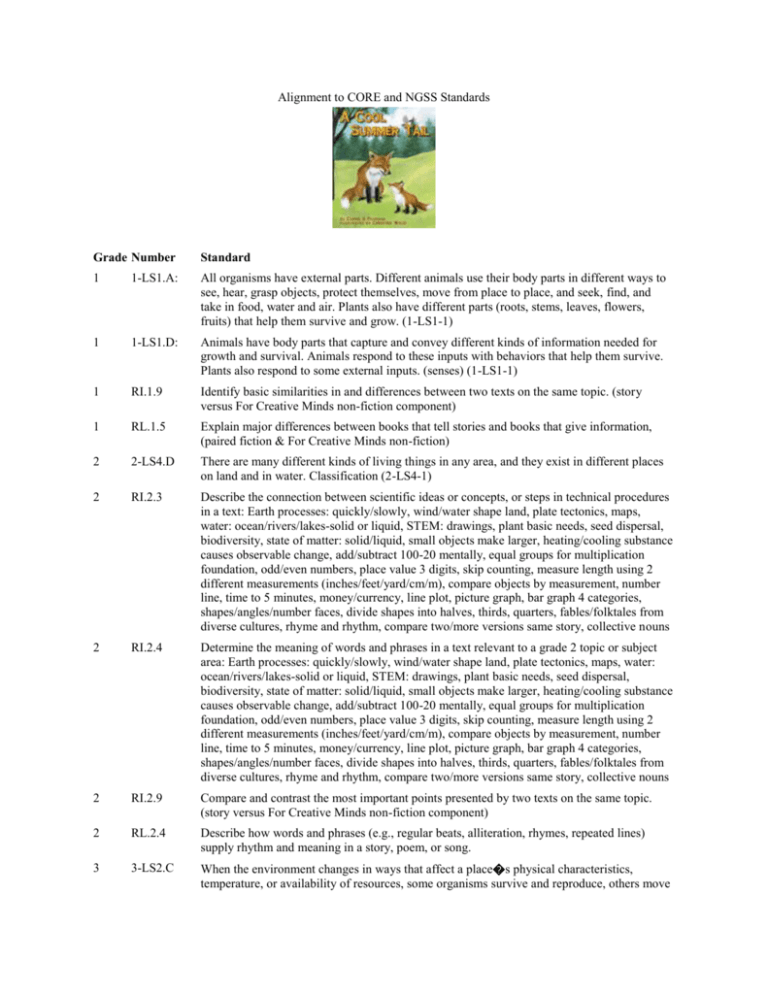
Alignment to CORE and NGSS Standards Grade Number Standard 1 1-LS1.A: All organisms have external parts. Different animals use their body parts in different ways to see, hear, grasp objects, protect themselves, move from place to place, and seek, find, and take in food, water and air. Plants also have different parts (roots, stems, leaves, flowers, fruits) that help them survive and grow. (1-LS1-1) 1 1-LS1.D: Animals have body parts that capture and convey different kinds of information needed for growth and survival. Animals respond to these inputs with behaviors that help them survive. Plants also respond to some external inputs. (senses) (1-LS1-1) 1 RI.1.9 Identify basic similarities in and differences between two texts on the same topic. (story versus For Creative Minds non-fiction component) 1 RL.1.5 Explain major differences between books that tell stories and books that give information, (paired fiction & For Creative Minds non-fiction) 2 2-LS4.D There are many different kinds of living things in any area, and they exist in different places on land and in water. Classification (2-LS4-1) 2 RI.2.3 Describe the connection between scientific ideas or concepts, or steps in technical procedures in a text: Earth processes: quickly/slowly, wind/water shape land, plate tectonics, maps, water: ocean/rivers/lakes-solid or liquid, STEM: drawings, plant basic needs, seed dispersal, biodiversity, state of matter: solid/liquid, small objects make larger, heating/cooling substance causes observable change, add/subtract 100-20 mentally, equal groups for multiplication foundation, odd/even numbers, place value 3 digits, skip counting, measure length using 2 different measurements (inches/feet/yard/cm/m), compare objects by measurement, number line, time to 5 minutes, money/currency, line plot, picture graph, bar graph 4 categories, shapes/angles/number faces, divide shapes into halves, thirds, quarters, fables/folktales from diverse cultures, rhyme and rhythm, compare two/more versions same story, collective nouns 2 RI.2.4 Determine the meaning of words and phrases in a text relevant to a grade 2 topic or subject area: Earth processes: quickly/slowly, wind/water shape land, plate tectonics, maps, water: ocean/rivers/lakes-solid or liquid, STEM: drawings, plant basic needs, seed dispersal, biodiversity, state of matter: solid/liquid, small objects make larger, heating/cooling substance causes observable change, add/subtract 100-20 mentally, equal groups for multiplication foundation, odd/even numbers, place value 3 digits, skip counting, measure length using 2 different measurements (inches/feet/yard/cm/m), compare objects by measurement, number line, time to 5 minutes, money/currency, line plot, picture graph, bar graph 4 categories, shapes/angles/number faces, divide shapes into halves, thirds, quarters, fables/folktales from diverse cultures, rhyme and rhythm, compare two/more versions same story, collective nouns 2 RI.2.9 Compare and contrast the most important points presented by two texts on the same topic. (story versus For Creative Minds non-fiction component) 2 RL.2.4 Describe how words and phrases (e.g., regular beats, alliteration, rhymes, repeated lines) supply rhythm and meaning in a story, poem, or song. 3 3-LS2.C When the environment changes in ways that affect a place�s physical characteristics, temperature, or availability of resources, some organisms survive and reproduce, others move to new locations, yet others move into the transformed environment, and some die. (secondary to 3-LS4-4) 3 3-LS3.A Many characteristics of organisms are inherited from their parents. (3-LS3-1 ) Other characteristics result from individuals� interactions with the environment, which can range from diet to learning. Many characteristics involve both inheritance and environment. (3-LS32) 3 3-LS3.B-1 Different organisms vary in how they look and function because they have different inherited information. (3-LS3-1) 3 3-LS3.B-2 The environment also affects the traits that an organism develops. (3-LS3-2) 3 3-LS4.C For any particular environment, some kinds of organisms survive well, some survive less well, and some cannot survive at all. (3-LS4-3) 3 3-LS4.D Populations live in a variety of habitats, and change in those habitats affects the organisms living there. (3-LS4-4) 3 L.3.6 Acquire and use accurately grade-appropriate domain-specific words and phrases: Weather prediction, weather versus climate, natural hazards, life cycles, changing environments: organisms survive/move/adapt/die, animal group behavior, inherited traits, instinct/learned behavior, extinct animals, fossils, individual advantages survival/mating, habitat survival: physical/behavioral adaptations, living things change habitats, force/motion: strength/direction/electric/magnetic, multiplication/division, unknown number m/d equation, m/d fact families, two-step word problems, place value rounding, fractions, time to minute, liquid volumes, scaled picture graph/bar graph, measurements to fractional inches, line plot, area, square units, area=multiplication/division, perimeter, shapes in different categories (rhombus/rectangle=quadrilateral), divide shapes by equal area, fables/folktales/myths from diverse cultures, compare/contrast stories from same author/series, 3 RF.3.4aAR/ATOS Read grade-level text with purpose and understanding. AR 3 RF.3.4aGuided Reading Read grade-level text with purpose and understanding. Guided Reading 3 RF.3.4aRead grade-level text with purpose and understanding. Lexile Level 420L - 820L Lexile Level 3 RI.3.10AR/ATOS By the end of the year, read and comprehend informational texts, including history/social studies, science, and technical texts, at the high end of the grades 2�3 text complexity band independently and proficiently. AR 3 RI.3.10Guided Reading By the end of the year, read and comprehend informational texts, including history/social studies, science, and technical texts, at the high end of the grades 2�3 text complexity band independently and proficiently. Guided Reading 3 RI.3.10By the end of the year, read and comprehend informational texts, including history/social Lexile Level studies, science, and technical texts, at the high end of the grades 2�3 text complexity band independently and proficiently. Lexile Level 420L - 820L 3 RI.3.4 Determine the meaning of general academic and domain-specific words and phrases in a text relevant to a grade 3 topic or subject area: Weather prediction, weather versus climate, natural hazards, life cycles, changing environments: organisms survive/move/adapt/die, animal group behavior, inherited traits, instinct/learned behavior, extinct animals, fossils, individual advantages survival/mating, habitat survival: physical/behavioral adaptations, living things change habitats, force/motion: strength/direction/electric/magnetic, multiplication/division, unknown number m/d equation, m/d fact families, two-step word problems, place value rounding, fractions, time to minute, liquid volumes, scaled picture graph/bar graph, measurements to fractional inches, line plot, area, square units, area=multiplication/division, perimeter, shapes in different categories (rhombus/rectangle=quadrilateral), divide shapes by equal area, fables/folktales/myths from diverse cultures, compare/contrast stories from same author/series, 3 RI.3.9 Compare and contrast the most important points and key details presented in two texts on the same topic. (story versus For Creative Minds non-fiction component) 3 RL.3.10AR/ATOS By the end of the year, read and comprehend literature, including stories, dramas, and poetry, at the high end of the grades 2�3 text complexity band independently and proficiently. AR 3 RL.3.10Guided Reading By the end of the year, read and comprehend literature, including stories, dramas, and poetry, at the high end of the grades 2�3 text complexity band independently and proficiently. Guided Reading 3 RL.3.10By the end of the year, read and comprehend literature, including stories, dramas, and poetry, Lexile Level at the high end of the grades 2�3 text complexity band independently and proficiently. Lexile Level 420L - 820L 4 4-LS1.A Plants and animals have both internal and external structures that serve various functions in growth, survival, behavior, and reproduction. (4-LS1-1) K K-ESS2.D Weather is the combination of sunlight, wind, snow or rain, and temperature in a particular region at a particular time. People measure these conditions to describe and record the weather and to notice patterns over time. (K-ESS2-1) K K-ESS3.A1 Living things need water, air, and resources from the land, and they live in places that have the things they need. (K-ESS3-1) K RF.K.2a Recognize and produce rhyming words. K RI.K.9 With prompting and support, identify basic similarities in and differences between two texts on the same topic. (comparing story to For Creative Minds non-fiction component) K-5 Dewey 571.70


